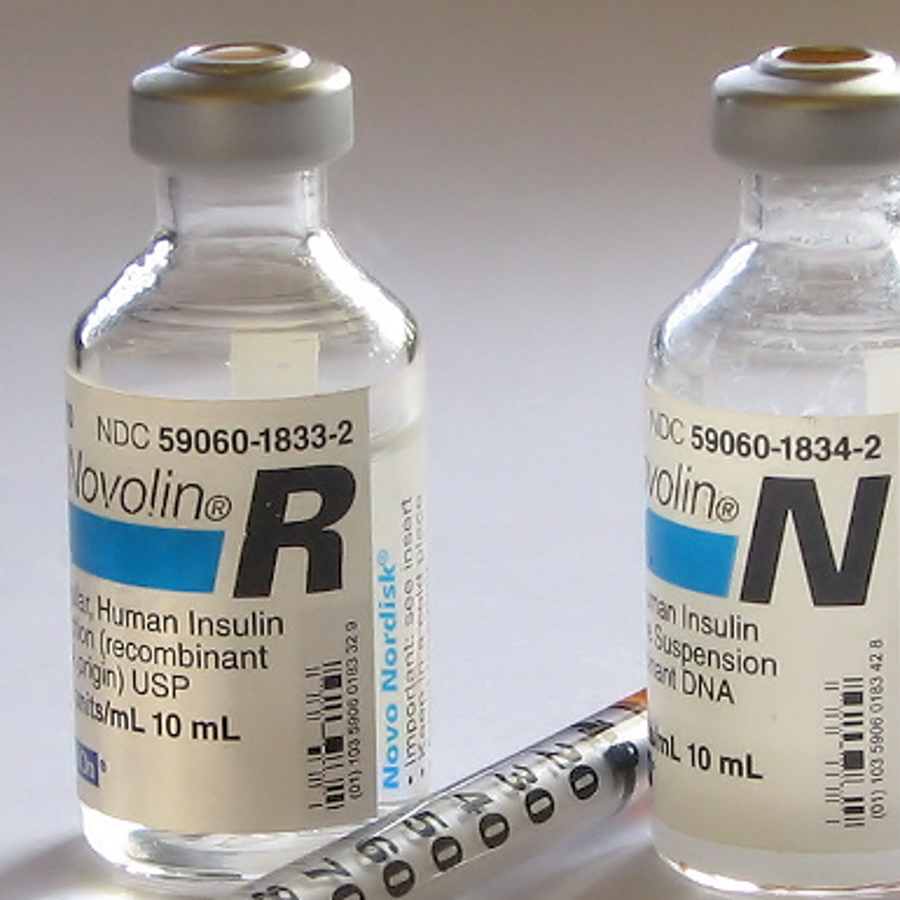
Where did scientists get the insulin gene for bacteria to make insulin?
February 25, 2010

- Related Topics:
- Editor's choice,
- Genes to proteins,
- Genetic engineering,
- Synthetic biology,
- GMOs
A graduate student from California asks:
"For bacteria to make insulin, where do they get the insulin gene to insert into the bacteria?"
Back in the 1970's scientists managed to coax bacteria into making the insulin that many people need to treat their diabetes. They did this by putting the human insulin gene into the bacteria.
The insulin gene they used came from human DNA. The scientists were able to get this gene in a couple of different ways, neither of which was very easy back in the 70's!
One group managed to make it on a machine called a DNA synthesizer. Like its name sounds, this machine makes DNA. Luckily the insulin gene is small since these machines could only make small snippets of DNA.
A second group managed to fish it out of human DNA. This was done by putting random pieces of human DNA into bacteria and finding the bacterium that had the insulin gene. This is really hard to do, but it used to be the only way to get big pieces of DNA.
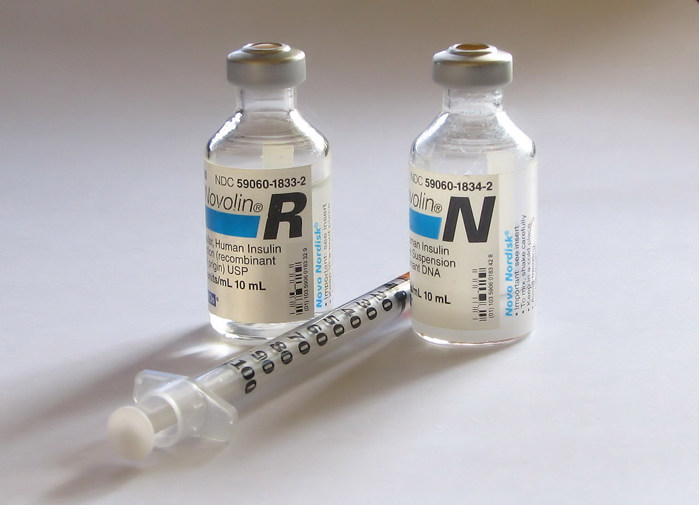
Nowadays, with the Human Genome Project, it'd be much easier. By knowing just a bit about the gene they're interested in, scientists can just go look it up on the computer. Then they can simply pluck the DNA they're interested in right out of a tube of human DNA.
Of course getting the gene isn't enough. You also need to get it into bacteria and have the bacteria be able to read the gene. Then you need to purify the insulin away from the bacteria.
Luckily you only asked about the first part so I'll focus on that. What I thought I'd do is go over how scientists originally got the insulin gene. Then we'll look at what they might do now in a similar situation.
But first, we're going to need to go into a little background. We need to go over what genes and proteins are and how they're related. Only then will we see how scientists were able to go from the insulin protein to its gene.
Genes are Recipes for Proteins
A big part of who we are can be found in our genes. Each gene has instructions for a small part of us.
For example, some genes have the instructions for giving you two eyes. Another gene has the instructions to make insulin. And so on for the rest of you.
But these genes, and their instructions, don’t do anything on their own. For example, the insulin gene won't help your body deal with sugar. To be of any use, a cell needs to read a gene and use the instructions to make a protein. It is the protein that then goes on to do the work.
So the insulin gene has the instructions for the insulin protein. And the insulin protein lets our bodies use the sugars we eat.
Imagine you are a cook in a restaurant. When someone orders a meal, you follow a recipe to make it. The meal will be eaten but the recipe is safe in the kitchen! So even though no one ate the recipe (thank goodness), it was still very important. Plus, you can keep using that recipe to make more meals.
So in the cell, each gene is like a "recipe" for a different protein. Unfortunately for scientists, the gene "recipes" aren't written in plain English! They have a language all their own.
The Genetic Code
Genes are made up of DNA building blocks called "nucleotides," which include adenine (A), thymine (T), cytosine (C), and guanine (G). You can think of a gene as a sequence of these letters (A, T, C, G).
These four letters make up a genetic alphabet. And just like any other language, letters aren't enough to have meaning. They need to be grouped together to form words.
Same thing with the genetic code. Each DNA letter doesn't mean a lot on its own. But when they are grouped into three letter words, they have meaning.
Again, words alone aren't that useful. Any recipe that consisted of "Stir" or "Add" would not help you cook much of anything. The words need to be grouped into sentences, sections, and/or chapters to be useful.
Same thing with the genetic code. Each gene is made of many three letter words strung together in a certain order.
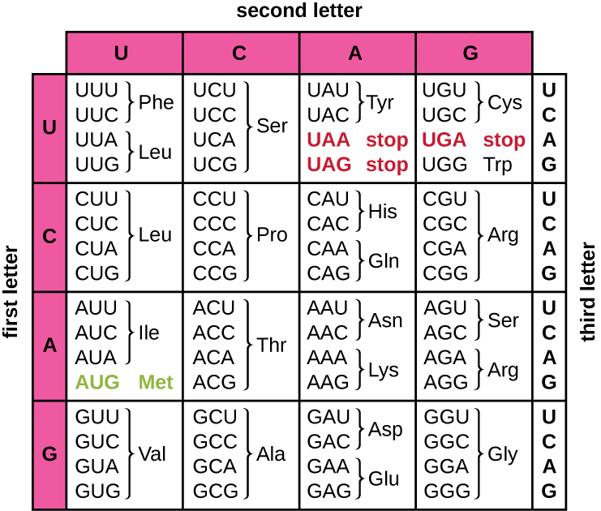
What does a three letter genetic word mean to a cell? It tells a cell which amino acid to put where in a protein.
Proteins are made up of twenty building blocks called "amino acids." Each protein is just a string of specific amino acids stuck together in a certain order.
Each three letter DNA word stands for one of these amino acids. So when a cell sees ATG in a gene, it knows to put a methionine. The cell then adds a lysine if the next word is AAA. And so on until a whole protein is made.
Some quick math shows an immediate problem. There are 64 possible three letter words and only 20 amino acids. To get around this, there are multiple words for the same amino acid.
This all matters for our story because scientists were able to figure out the order of amino acids in insulin. But they needed the gene DNA to tell bacteria how to make the protein.
Finding the Insulin Gene
So scientists knew the order of amino acids in human insulin. From this, two groups were able to get DNA that could be used to make it. Only one group got the "real" sequence though.
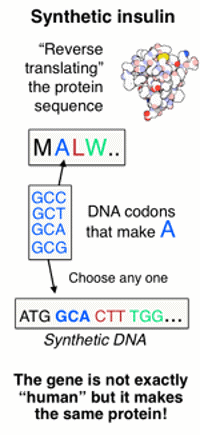
Both groups used the genetic code to work backwards to figure out what the insulin gene might look like. A group led by Stan Cohen and Herbert Boyer had a machine make a DNA that encoded insulin.1 It wasn't the "true'' human insulin gene, but that didn't matter. As long as the codons made the right amino acids, the actual insulin protein would be the same. They didn't need the exact piece of DNA to get the same protein.
Another group, led by Walter Gilbert, wanted to get the actual human insulin gene.2 This was no easy task: our human DNA consists of 25,000 other genes. And genes only make up a tiny bit of our DNA.
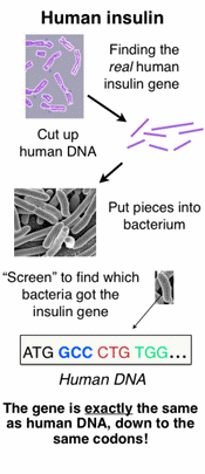
The first step to finding the insulin gene was to chop up human DNA with special DNA-cutting proteins. This way, each piece of DNA would only contain one gene.
Then, they put all these DNA pieces into a bunch of bacteria. Scientists hoped that at least one bacterium would take up the DNA that had the insulin gene.
Scientists then screened for the bacterium with the insulin gene (click here and go to "Production" to learn how). And they found it.
Today, things would be much easier. We have the human genome sequence, which is all the DNA in a human body
If we had the insulin protein sequence, we would simply use computer programs that can find the right human DNA in our genome.
Then we'd use something called PCR to pluck the gene right out of some human DNA. Sort of like what Gilbert did, but much faster!

Author: Ed Chuong
When this answer was published in 2010, Ed was a Ph.D. candidate in the Department of Genetics, studying mammalian evolution and genomics in Julie Baker's laboratory. Ed wrote this answer while participating in the Stanford at The Tech program.
 Skip Navigation
Skip Navigation
